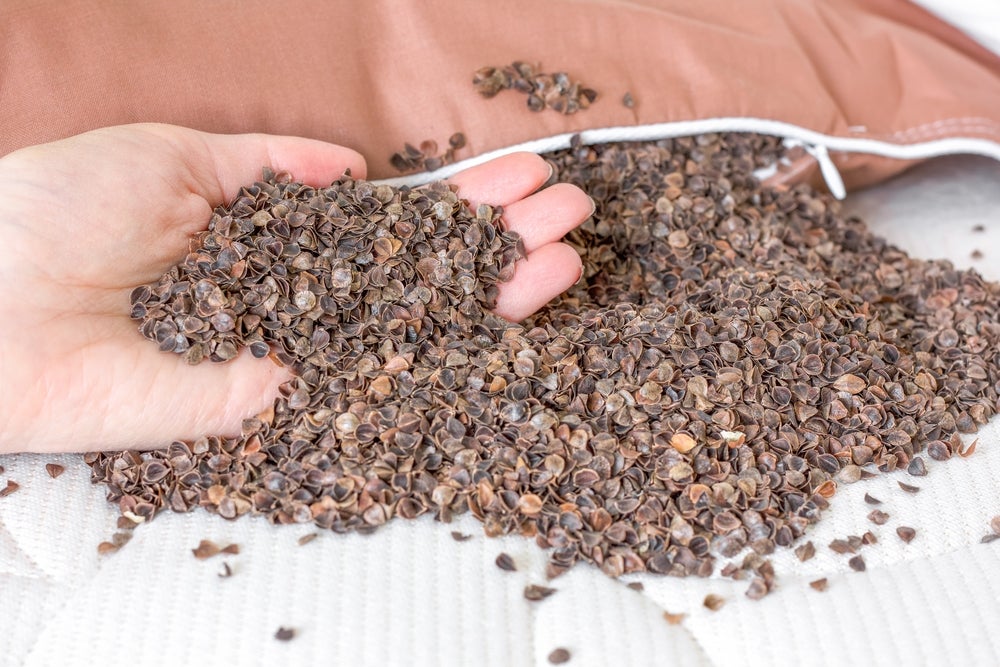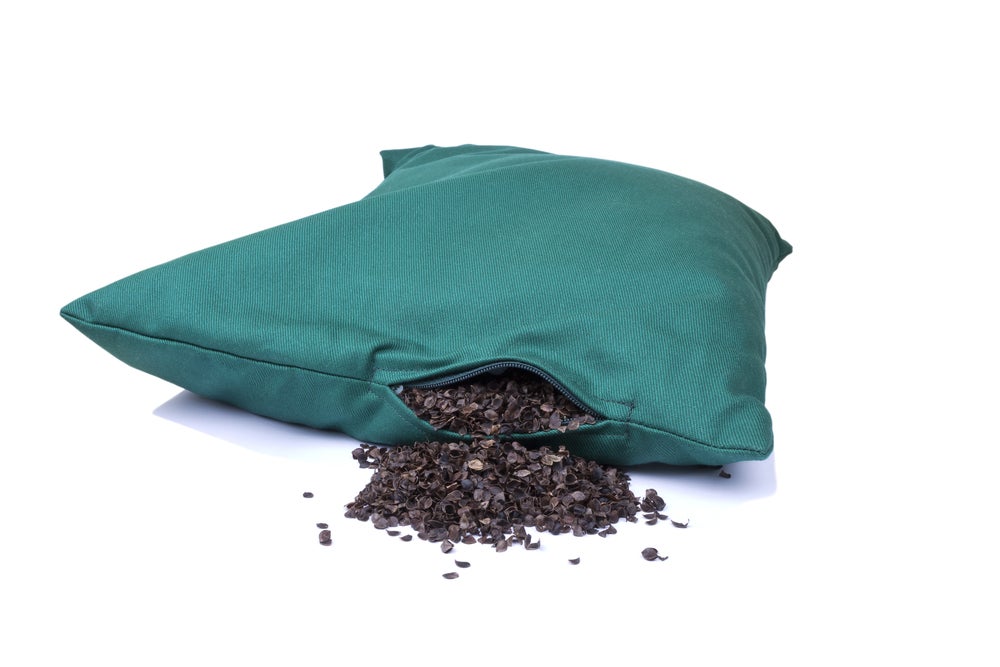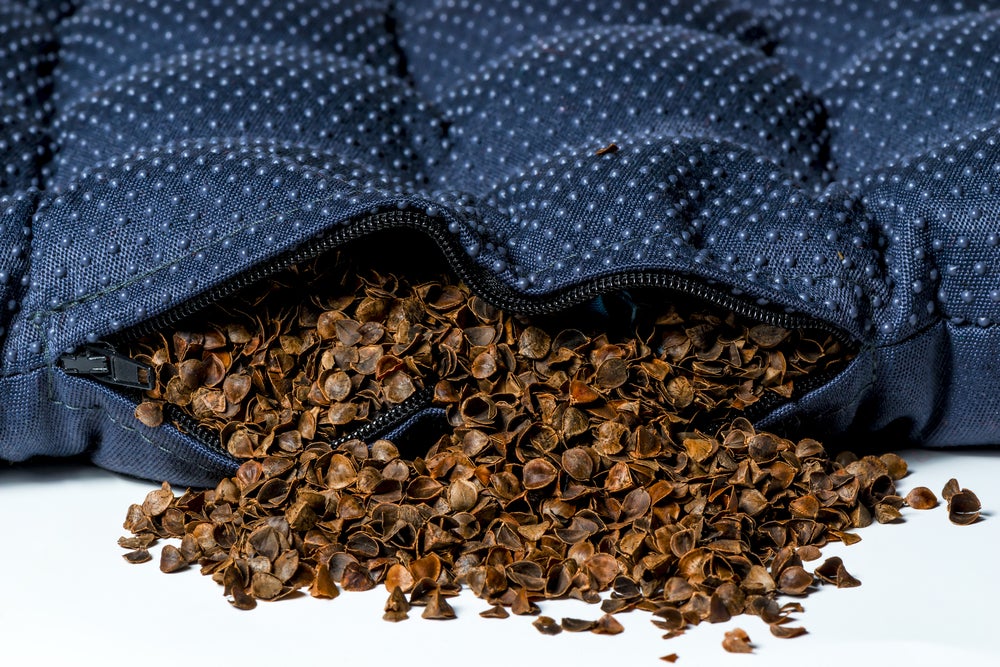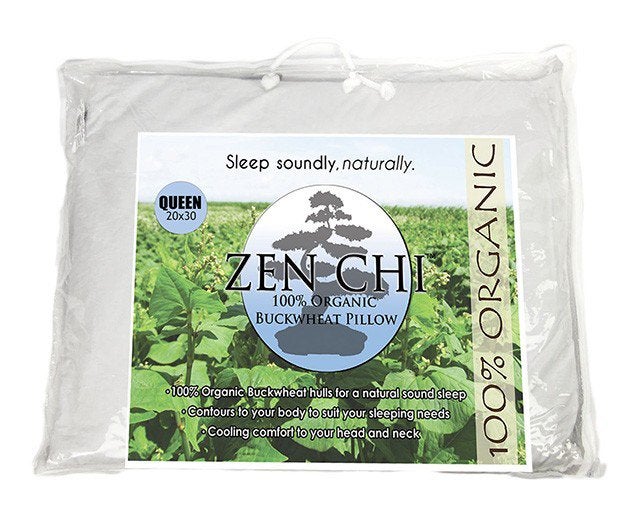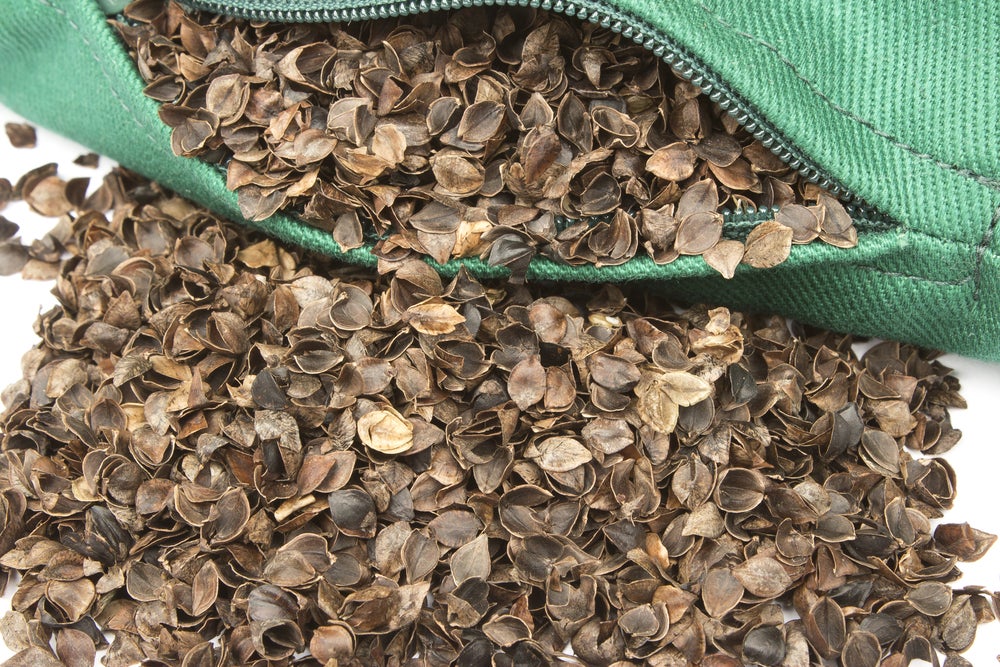A buckwheat pillow, otherwise known as a Sobakawa, is a traditional Japanese pillow filled with the hulls that encase buckwheat seeds. They are springy under compression but provide a firm, contouring support that supports proper rest of your head and neck positioning. Because they claim to ease tension and strain through spinal alignment, they have become popular sleep support aides for anyone looking for a good night’s rest. The benefits and side effects of a buckwheat pillow are fairly simple due to their simple design, and I’ve provided a quick guide below so you can better determine whether or not it is a product you may want to consider.
Our Editor’s Choice:
As with many types of pillows, not all buckwheat pillows are created equal. The Zen Chi Buckwheat pillow is a particularly well-reviewed option that gets extra credit on account of its use of organic buckwheat filling, plus the fact that you can personally tailor its firmness to suit your sleeping preferences. By adding or removing buckwheat hulls from the pillow its firmness is infinitely variable, meaning you no longer have to play that frustrating guessing game of whether or not you need to purchase a medium, firm, or extra firm pillow. Word to the wise, keep some extra buckwheat hulls around as spares, as they have a tendency to settle/compress a little bit after the first couple of weeks of use.
Buy the Zen Chi Pillow on Amazon Now
You may be interested in: Best Buckwheat Pillow
What is Buckwheat?
Buckwheat is a seed-like grain native to Asia. For centuries, it has been a staple for both feeding domestic animals as well as its use for human consumption. This seed is actually considered a fruit and grows within a husk – a shell-like casing that protects the seed as it matures. This part of the plant is inedible, but it was utilized in other ways, one being a long-lasting, durable filling for pillows and mattresses. Today, buckwheat is grown on many continents as its nutritional benefits and hull use has spread far and wide. Pillow companies have added the benefits of buckwheat products to their offers, making them more widely known and more readily available. The seeds are removed from the hulls, and then the hulls are cleaned and used within a material casing. Usually, these cases are made from natural fibers such as cotton and silk and are adjustable to add, remove, or refresh your hulls throughout the life of the pillow (which can be rather long)!
The Benefits of a Buckwheat Pillow
The benefits and positive side effects of a buckwheat pillow may differ from person to person but are substantiated by the thousands of consumers who have found pain relief and comfort with the regular use of the pillow. Since we’ve personally reviewed few pillows ourselves and researched other quality choices, we can honestly say this is a pillow worth taking a closer look at.
Better Sleep
First and foremost, buckwheat pillows have become a popular sleep product since they truly do support proper posture and spinal alignment. When on your back and stomach, you need a thin pillow that holds your head level between your shoulders and also provides support to the gap created by the arch of your neck. Side sleepers need to hold their head high and between their shoulders and also have a proper material fill to fill the gap between their head and shoulders.
A buckwheat pillow is malleable and non-shifting to allow for a contouring to your unique body shape and comfort needs. It helps to allow the important cervical alignment, and when this positioning is achieved, your body is better able to relax and rest through the sleep stages uninterrupted.
Reduced Snoring
Many people who snore do so because of poor sleep posture. Although this pillow does not claim to solve all your snoring problems, especially if you suffer from sleep apnea, it can influence a better posture to allow your airways to be kept open through the night.
If your neck muscles are unable to relax through the night due to poor support or your head is held too high or is allowed to fall too far back, then you may compromise your airway which can lead to snoring. Your airway runs along your cervical spine, and by keeping your spine aligned, you also support your airways. If you suffer from disruptive snoring that is not affected by changes in your posture, you should always check with a doctor for any underlying causes.
Muscle Support
The leading cause of neck and back pain that is not associated with injury or illness is poor sleep posture. As explained, a buckwheat pillow can help support your head and neck in the correct position to support your spine and allow true relaxation. Your muscle and other soft tissues will work to keep your spine aligned- after all, your spine is the main support of your central nervous system from which your entire body functions. These muscles, ligaments, and tendons can become fatigued through the night and will attempt to compensate for one another – leading to uncomfortable pain and tenderness. Without adjustment and care over time, these types of stressors can lead to headaches and sleeplessness amongst other things.
Promotes Airflow for a Cooler Sleep
These pillows do more than just support your personal airways, they also promote airflow of the product itself to provide you with a cooler night’s sleep. Buckwheat hulls are slightly cupped, triangular in shape, smooth, and thus create thousands of tiny air pockets between them. They never compress and only fit more closely together when weight is applied. They also do not radiate or hold heat, making them an ideal filling for anyone who sleeps hot.
May Aide in Migraine Relief
There are many studies behind the causes of migraines- some concentrate on spinal alignment, soft tissue strain, airway support, and pressure points. The cause of migraines may be varied from person to person, but there have been many reports of a reduction of incidences and relief through the use of a buckwheat pillow. This is mainly due to how well it supports soft tissues and airways, as well as providing soft pressure against specific points along your neck and skull. These pressure points help trigger relaxation through the regulation of blood through the brain and a release of endorphins – a feel-good hormone.
Hypoallergenic and Dust Mite Resistant
There are no materials that are considered a food source in the construction of these materials. This means they do not attract bugs or insects, and nor are they a likely environment for allergens to collect. They are considered a hypoallergenic and dust mite resistant choice since they provide excellent airflow- which is not conducive to these aforementioned issues. If you are very sensitive to certain plants, especially those used for animal consumption, you may want to check with your doctor despite there being little to few reports of true buckwheat allergies.
Long Lasting
Buckwheat pillows, on average, can be used up to 10 years with proper care. This is often determined by the quality and thickness of the material used, as the hulls can wear against the thin material through consistent friction over time. Well sewn seams and heavy-duty zippers help hold in hulls, and they need to be durable enough to resist against the heft of the hulls (as these pillows can be very heavy). The hulls themselves can begin to wear down too with use, but if you have an adjustable pillow, you can easily refresh them with the purchase of a bag of hulls made specifically for this reason. This makes them both environmentally friendly as well as economical!
Adjustable
Mentioned above, many of these pillows provide adjustability, meaning you can add to or remove hulls to fit your comfort needs. This is especially important for the proper placement of your head and neck, and the fact that our body is not made exactly the same, the pillows will offer different specific needs. A higher pillow is generally needed by side sleepers, whereas thinner choices are needed for back and stomach. Stomach sleepers, in particular, need a practically non-existent lift and being able to remove hulls for this purpose allows them to be a popular pick for a wider variety of sleepers. Just be aware that not all companies provide this choice.
Most buckwheat hulls harvested for pillow use are organically sourced, ensuring you are not exposed to any chemical or pesticide processes. They also almost always use a 100% cotton or organic material source for their casings, making them a possible vegan choice as well. Since the construction is simple, most of these companies that manufacture them are considered more environmentally friendly than others.
Buy the Zen Chi Pillow on Amazon Now
The Cons (or Are There Any?) of a Buckwheat Pillow
There truly aren’t many cons of a buckwheat pillow. The worst problem you may run into is a pillow that is of poor quality that doesn’t last long during prolonged use, and that can easily be avoided through the proper research of a company and their products. Though, there are a few things to consider before making an investment in these types of pillows since they do not follow a conventional design. They easily are not easily found or sold on store shelves and almost always need to be ordered.
Takes Some Time to Get Used To
Buckwheat hulls are much different than the softer fibers, feathers, and foams used as stuffing in most pillows. They can provide cushioning and contouring, but are too stable to feel and do not shift with your body – rather it holds you in place. Most people state to give yourself about 5 days to get used to (which we’ll corroborate). Any adjustable pillow type does require some trial and error before finding the exact fill amount to fit your comfort needs. This takes patience and may even result in a few nights of not-quite-so-comfortable sleep until you find the perfect fit for you. Fans of adjustable pillows claim this is well worth the effort, however, as you’ll end up basically with a customized pillow.
Natural Odor
Buckwheat has a natural earthy smell that is considered aromatic and calming. It may be a strong smell upon opening due to storage techniques, or it can’t be noticeable at all if the hulls have ever been roasted when being prepared for consumers. Some consumers do not find it pleasant, although it does air out and dissipate easily.
Rustling Noise
The hulls do create a slight rustling and crunching noise when moved and laid upon. It is fairly muted and easy to get used to over time, but it can be slightly distracting until you get used to it in your everyday routine. Since your head is held in place, the noise is not as noticeable once you’re sleeping on the pillow, but it can be otherwise if you are a restless sleeper. The good thing is that the pillow is easily shapeable, and you can create the indents you need to rest your head and support your neck and shoulders when needed.
Not Washable (Cases Are!)
Do not wash buckwheat! Even though it does not really absorb water well, it can ruin the strength of the hulls and allow them to weaken and be less durable. Plus, it is very heavy (more on that below) and will probably throw your washer out of balance permanently. Removable casings are washable, however, and should be washed regularly according to the manufacturer’s directions.
Heavy
These pillows are heavy – as in up to 12 pounds heavy. They are not made to be the pillow you prop up to lean against for television watching as gravity will drag the hulls to the bottom of the casing. They also are not for pillow fights unless you are truly trying to defend yourself. Rather, they are made to hold still and not shift to provide the proper body placement you need.
Conclusion
The benefits and side effects of a buckwheat pillow are varied and well worth the consideration. They are comforting and have a myriad of benefits that can help support your overall health. Although they may take a bit of getting used to, most consumers state within 3 to 5 days they have its use all figured out, and the noise is no longer even noticeable to them. With claims to help provide proper posture, headache-and-migraine relief, and reduce snoring, this is definitely worth considering to help you get a proper night’s rest.
Photo credit: Lili.Q/Shutterstock; BogDarena/Shutterstock; NataLT/Shutterstock; kosmos111/Shutterstock
Frequently Asked Questions
How can I clean my buckwheat pillow?
You can’t wash buckwheat hulls in water; this will ruin them, so the pillow should not be put into a washing machine or dryer. However, if the buckwheat pillow you purchase has a cotton cover, you can clean the cover by removing the buckwheat and putting the cover in the washing machine. Removing the buckwheat hulls is not difficult. Just empty them into another pillow case. If the case on your buckwheat pillow is made from 100 percent cotton, it may shrink in the washing machine, so make sure to wash it in cold water and hang it to dry. If you like, while the case is being cleaned, you can put the buckwheat hulls into a large pan and place it in a sunny spot near a window to air them out.
Is a buckwheat pillow safe for children?
A buckwheat pillow is a great choice for children, especially if the case is made from 100 percent organic cotton and the buckwheat is organically grown without the use of pesticides. However, buckwheat pillows are not a good choice for babies. Aside from the fact that babies still in a crib should not have a pillow at all, children three years old and under should not use a buckwheat pillow because there is a remote risk of choking if a hull or two somehow gets out of the fabric case.
Can I have an allergic reaction to the buckwheat in a pillow?
While buckwheat is considered to be hypoallergenic and reactions to buckwheat pillows are rare, it is considered to be a serious food allergen because it can cause severe reactions such as anaphylaxis in allergic individuals. Other forms of an allergic reaction such as asthma and rhinitis can occur through ingestion, occupational exposure, and domestic exposure through pillows filled with buckwheat husks. If you find that your buckwheat pillow is causing issues, speak with your doctor, stop using the pillow, and get allergy testing.
How often should I replace my buckwheat pillow?
One of the great advantages of a buckwheat pillow is its long lifespan — at least 10 years, with some brands claiming up to 20 years. A lot also depends on the quality of the materials. However, over time, even the best quality buckwheat will break down, degrade and lose its freshness. To rejuvenate your pillow, it’s a good idea to periodically replace some of the buckwheat in the pillow and remember to wash the case every few weeks.
